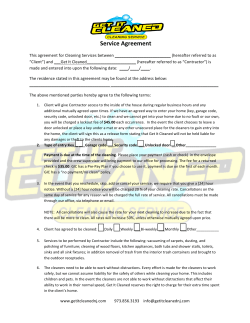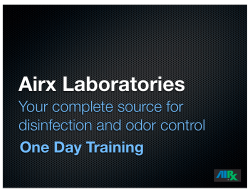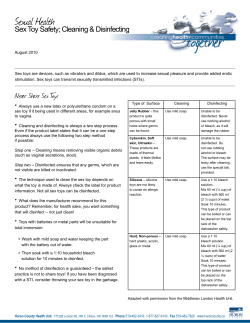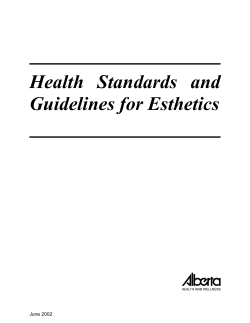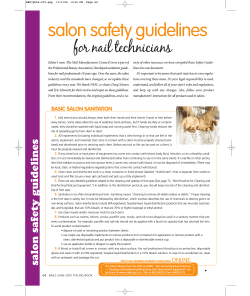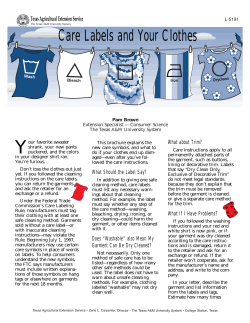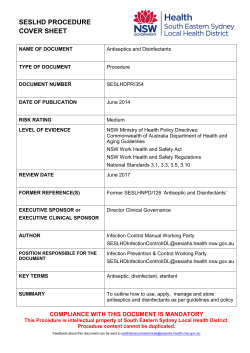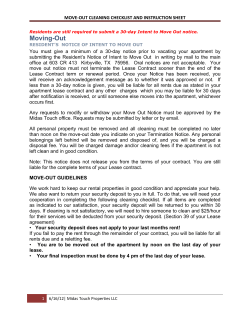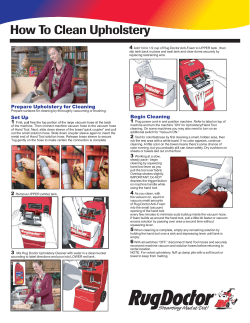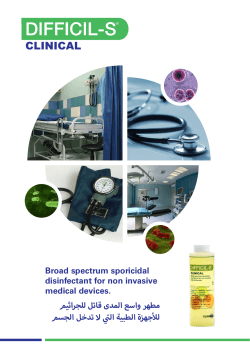
Guideline for Cleaning and Disinfecting Manicuring and Enhancement Equipment
Guideline for Cleaning and Disinfecting Manicuring and Enhancement Equipment These guidelines outline procedures cleaning (sanitizing) and disinfecting all types of equipment used during manicuring and enhancement services including items such as manicuring bowls, pushers, nippers, clippers, abrasive files and buffers. In the salon, all tools, implements, devices or other pieces of equipment must be properly cleaned and disinfected before it comes into direct contact with a client, as required by the licensing rules and regulations of your region, state or country. Proper Cleaning and Disinfection Just about everything in the salon has a hard or soft surface of some type. Some examples are manicuring tabletops and arm cushions, finger bowls, towels, files/buffers, implements, etc. Any of these surfaces coming into direct contact with a client’s skin is considered “contaminated”. All contaminated surfaces must be thoroughly and properly: 1) cleaned and then 2) disinfected. To be considered properly clean, a surface must first be thoroughly scrubbed free of all visible signs of debris or residue (contamination). Proper cleaning is the total removal of all visible residue from every surface of tables, tools and equipment, followed by a complete and thorough rinsing with clean water. (see below, Methods of Proper Cleaning) Proper cleaning (also called sanitizing) must be performed before continuing with the disinfection step. Proper disinfection is the destruction of potentially harmful or infection-causing microorganisms (pathogens) on a precleaned surface. (see below, Methods of Proper Disinfection) Disposable (Single Use) items Items that the manufacturer designs to be disposed of after one use are called “disposable” or “single-use”. These items must be properly disposed of after one use on a single client. Reusing these items is considered an unsanitary, improper and unprofessional practice. Some examples of disposable items are: cotton balls, gauze pads, wooden implements, disposable towels, toe separators, tissues, wooden sticks, arbor bands/ sleeves for electric files and certain abrasive files and buffers. Items damaged during the cleaning and disinfecting process are considered single-use and must be discarded after every client. Proper Product Application Some types of products can become contaminated if improperly used. Some examples are: creams, lotions, scrubs, paraffin wax, masks, and oils. These products must always be used in a sanitary manner that prevents contamination. For example, paraffin and nail oils should not be applied with a brush (or spatula) that has touched the skin. These practices may introduce bacteria into the product and cause contamination that can render products unsafe for use. To avoid product contamination always: (a) Dispose of used or remaining product between clients. (b) Use single-use disposable implements to remove products from containers for application or remove product with a clean and disinfected spatula and put product to be used into a disposable or disinfectable service cup. (c) Use an applicator bottle or dropper to apply the product. Proper Disinfection of Multi-Use Tools and Equipment Some items are designed to be used more than once and are considered to be “multi-use”. Multi-use items are sometimes referred to as “disinfectable”, which means that the implement can be properly cleaned and disinfected while retaining its usefulness and quality. Multi-use items are designed for use on more than one client, but require proper cleaning and disinfection between each use. Examples of multi-use items include cloth towels, manicure bowls, nippers, pushers and certain abrasive files and buffers. Multi-use items come in three varieties; 1) Hard and non-absorbent items constructed of hard materials that do not absorb liquid, i.e. metal, glass, fiberglass or plastic. These should be cleaned and disinfected as described below. 2) Porous and/or absorbent items constructed of materials such as cloth or wood with surfaces that may absorb or are penetrated by liquids, i.e. scrub brushes for nails, cushioned abrasive buffers, cloth towels and chamois. They should be cleaned and disinfected as described below. 3) Self-disinfecting items that will not support the growth of bacteria, viruses or fungi. Examples are application brushes used for nail polish, primers along with artificial enhancement application brushes. Due to the nature of these products, the brushes do not require disinfection and should be cleaned, used and stored only as recommended by the product manufacturer. Individual Client Packs Tools/instruments kept in individual packs must be properly cleaned and disinfected after each use. If a client provides their own implements/tools, they must be properly cleaned and disinfected before use. State rules require all tools and equipment to be disinfected before being reused, even if used by the same client! Improperly cleaned and disinfected implements may grow infection/disease-causing organisms before the client returns for their next visit, thereby increasing the risk of infection. Never use air-tight bags or containers for storage as these can promote bacterial growth. Methods of Proper Cleaning Proper cleaning requires liquid soap/detergent, water and the use of a clean and disinfected scrub brush to remove all visible debris and residue. All items should be scrubbed with a clean and disinfected scrub brush under running water. Cleaning is not disinfection; disinfection is an entirely separate step. Different items are cleaned in different ways. This often depends on what the item is made of and how it was used. NOTE: the cleaning step must be properly performed before an item can be disinfected. All items must be thoroughly rinsed and dried with clean cloth or paper towels prior to putting them into a disinfectant. Cleaning (sanitation) Method Examples Scrub Brush Abrasive files, buffers, paddles Ultrasonic Cleaner Metal pushers & nippers Acetone Soak Metal electric file bits used on enhancements Washing machine Cloth towels, linens, chamois Towelette/Wipe Electrical equipment, table tops Methods of Proper Disinfecting After proper cleaning, all reusable implements/tools must be disinfected by complete immersion in an appropriate disinfecting solution (see below, Appropriate Disinfectants). The item must be completely immersed so that all surfaces, including handles, are soaked for the time required on the disinfectant manufacturer’s label. In general, U.S. Environmental Protection Agency (EPA) registered disinfectants require 10 minute immersion; isopropyl and ethyl alcohol require 5 minutes. Remove items after the required time, using clean and disinfected tongs or gloves to avoid skin contact with the disinfectant solution. If required by the instruction label, rinse thoroughly in running water. Allow items to air dry completely by placing them on top of a clean towel and covering them with another clean towel. Thick foam cushioned buffers should have the moisture pressed out while in between clean towels to ensure the buffer is dry before storing in a sanitary manner. It is recommended to spray 60-90% isopropyl or ethyl alcohol on clean, porous abrasives and buffers to disinfect them. A contact time of 5 minutes is sufficient for proper disinfection. Disinfectant products are designed to destroy diseasecausing microorganisms (pathogens) on non-living surfaces, such as those described in this document. They are not appropriate for use on living skin and contact with skin should be avoided. Methods for Proper Storage of Tools and Equipment. Appropriate salon disinfectants include the following: All properly cleaned, disinfected and dried implements/ tools must be stored in a sanitary manner. A lined drawer is usually adequate, provided it is clean, contains only clean items and is properly labeled. Store soiled or used items in a properly labeled, covered container separate from clean items. Never use airtight containers or zipper bags – these may promote bacterial growth! (a) EPA-registered Hospital disinfectants with bactericidal, fungicidal and virucidal claims on the label. (b) 10% bleach solution (1 part bleach to 9 parts water) (c) Isopropyl alcohol, 70%-90% solution (d) Ethyl alcohol, 70%-90% solution Abrasive Files, Buffers and Electric File Bits After each use abrasive files, buffers, blocks or bits must be thoroughly cleaned by manually brushing with a clean and disinfected brush or by other adequate methods to remove all visible debris. The sides of foam cushioned buffers, blocks or other abrasives should also be brushed after each use. After proper cleaning abrasives files, buffers and blocks are best disinfected by immersing in (or saturating with) 70-90% isopropyl or ethyl alcohol for 5 minutes. Once electric bits have been thoroughly cleaned, they must be disinfected by complete immersion in an appropriate EPA registered disinfectant, as described in the next section. Any porous (absorbent) abrasive file, buffer, block, band, etc. that comes in contact with broken, damaged, infected or unhealthy skin or nails must be properly disposed of immediately, as described below. Appropriate Disinfectants How do you know if a disinfectant product is suitable for professional salon use? Standards and requirements vary from country to country, but in the United States, the EPA registered Hospital disinfectants with bactericidal, fungicidal and virucidal claims on the label are best for use in salons. Some disinfectants are designed for use on hard-surfaces while others are best used on porous or absorbent items. EPA-registered Hospital disinfectants are good examples of a type that is suitable for hard surfaces. Isopropyl alcohol and ethyl alcohol (70 – 90%) are suitable for porous/absorbent items. Contact with Blood, Body Fluid or Unhealthy Conditions If blood or body fluid comes in contact with any salon surface, the nail professional should put on a pair of clean protective, disposable gloves and use an EPAregistered Hospital liquid disinfectant or a 10% bleach solution to clean up all visible blood or body fluid. In case of an accidental cut, clean with an antiseptic and bandage the cut. Disposable items, such as a cotton-tipped wood stick must be immediately double-bagged and discarded after use, as described at the end of this section. Any non-porous instrument or implement that comes in contact with an unhealthy condition of the nail or skin, blood or body fluid, must be immediately and properly cleaned, then disinfected using an EPAregistered Hospital disinfectant as directed or a 10% bleach solution for 5 minutes. Any porous/absorbent instrument that comes in contact with an unhealthy condition of the nail or skin, blood or body fluid must be immediately doublebagged and discarded in a closed trash container or biohazard box. 1 Some EPA disinfectants are registered for hospital use, but may not say “Hospital” on their label. In these cases, the product label MUST claim effectiveness against Salmonella choleraesuis, Staphylococcus aureus, and Pseudomonas aeruginosa. When in doubt, be guided by your local rules and regulations. Additional Information about Disinfectants and Cleaners 1) Disinfectants must be mixed, used, stored and disposed of according to manufacturer’s label instructions (proper mixing ratio is of the utmost importance to be an effective disinfectant). Some are ready to use and do not require mixing. 2) U.S. Federal Law prohibits the use of EPA-registered disinfectants in a manner that is contrary to its label. 3) Disinfectants must be prepared fresh every day (including spray bottles). Further, they must be replaced immediately if the solution becomes visibly contaminated. Disinfectant solutions will lose their strength upon standing and become ineffective within 24 hours. Use a logbook to record when fresh disinfectant is made. 4) Disinfectants are ineffective if implement/tools are not properly cleaned prior to use. 5) Just spraying disinfectants on tools and equipment is inadequate. Pre-cleaning is required before spraying the disinfectant and most types require ten minute contact to be effective. 6) Disinfectants can damage or rust some metal tools if improperly used. 7) All disinfectant containers must be properly labeled. Disinfectant solutions prepared in the salon must list on the container: the contents and percentage solution (concentration), and use a logbook to record the date and time of mixing. Check the label for the product’s expiration date. 9) Ultra-violet light cabinets are not suitable replacements for liquid disinfectant solutions. These can be used for storage after properly cleaning and disinfecting implements/tools with a liquid solution. 10) Read all warning labels and precisely follow manufacturer’s instructions. 11) These guidelines are believed to be highly effective and are designed to help avoid unforeseen pitfalls, problems and complications. These guidelines are not a replacement for local government standards, rules or regulations. Always consult federal, state and local laws and regulations, which may vary somewhat from these recommendations. Legal Notice This document is intended to provide interested persons with helpful examples of procedures for use in the salon environment. This document is not intended to be a substitute for comprehensive training or requirements, or to prescribe rules or standards, or to define or create legal rights or obligations. All persons involved in providing manicuring and enhancement services have the responsibility to determine that the procedures they practice comply with any current federal, state and local laws and regulations that may be applicable. Neither INTA, the NMC, their individual member companies, any of their employees, subcontractors, consultants, or other assigns, make any warranty or representation, either express or implied, with respect to the accuracy or completeness of this document; nor do any of the foregoing assume any liability for any use of anything in this document. 8) All brushes used for cleaning purposes, i.e., nail brushes and electric-file bit cleaning brushes, must be properly cleaned and disinfected between each use. Rev. 1/07 401 North Michigan Avenue, Suite 2200 Chicago, Illinois 60611 p: 312.321.5161 ChicagoMidwestBeautyShow.com Nail Manufacturers Council of the Professional Beauty Association 15825 N. 71st Street, Suite 100 International Nail Technicians Association (INTA) is a registered trademark of Cosmetologists Chicago. Scottsdale, AZ 85254-1521
© Copyright 2025
